County Leitrim: Difference between revisions
No edit summary |
|||
| (7 intermediate revisions by 2 users not shown) | |||
| Line 2: | Line 2: | ||
|name=County Leitrim | |name=County Leitrim | ||
|irish=Contae Liatroma | |irish=Contae Liatroma | ||
|map image= | |map image=Leitrim Ireland (BI Sect 7).svg | ||
|picture=Glencar waterfall01.jpg | |picture=Glencar waterfall01.jpg | ||
|picture caption=Glencar Waterfall, Glencar Lough | |picture caption=Glencar Waterfall, Glencar Lough | ||
|province=[[ | |province=[[Connaught]] | ||
|area= | |area= | ||
|population= | |population= | ||
| Line 11: | Line 11: | ||
|biggest town= | |biggest town= | ||
}} | }} | ||
The '''County of Leitrim''' is a [[Counties of the Republic of Ireland|county] | The '''County of Leitrim''' is a [[Counties of the Republic of Ireland|shire]] in the [[Republic of Ireland]], belonging to the Province of [[Connaught]]. It is named after the village of [[Leitrim, County Leitrim|Leitrim]]. The population of the county is 31,798 according to the 2011 census.<ref>[http://census.cso.ie/sapmap2011/Results.aspx?Geog_Type=CTY&Geog_Code=28&CTY=282011 Census 2011 County Leitrim Overview]</ref> | ||
{{ | ==Geography== | ||
Leitrim is the 26th largest of the 32 counties by area and the smallest by population on [[Ireland|the island]].<ref>{{cite book| first=Eoghan| last=Corry| title=The GAA Book of Lists| publisher=Hodder Headline Ireland| year=2005| id= | pages=186–191}}</ref> It is the smallest of Connaught’s five counties in both size and population. Leitrim is bordered by the counties of [[County Donegal|Donegal]] to the north, [[County Fermanagh|Fermanagh]] to the north-east, [[County Cavan|Cavan]] to the east, [[County Longford|Longford]] to the south, [[County Roscommon|Roscommon]] to the south-west and [[County Sligo|Sligo]] to the west. Fermanagh is in [[Northern Ireland]] while all the other neighbouring counties are within the Republic. | |||
The [[townland]]s of Edercloon<ref>Townland of Edercloon: {{wmap|53.812961|-7.891515|zoom=14|base=outline_detached}}</ref> and Clooneen (Shanly)<ref>Townland of Clooneen (Shanly): {{wmap|53.802486|-7.900708|zoom=14|base=outline_detached}}</ref> form two distinct detached parts of the county locally situate in the county of Longford. | |||
===Baronies=== | |||
There are five baronies in the county. They are [[Carrigallen]], [[Drumahaire]], [[Barony of Leitrim|Leitrim]], [[Barony of Mohill|Mohill]] and Rosclogher.<ref>[http://www.logainm.ie/Viewer.aspx?text=Rosclogher&streets=no Placenames Database of Ireland. Baronies of County Leitrim. Retrieved 5 December 2011.]</ref> | |||
===Largest towns=== | |||
# [[Carrick-on-Shannon]], 3,980 | |||
# [[Manorhamilton]], 1,336 | |||
# [[Ballinamore]], 889 | |||
# [[Kinlough]], 1,018 | |||
# [[Mohill]], 928 | |||
===Towns & villages in north Leitrim=== | |||
[[File:Tour boat, Lough Gill.jpg|250px|thumbnail|A tour boat on Lough Gill. One of the many lakes in County Leitrim.]] | |||
[[File:Creevelea Friary S 2007 08 16.jpg|250px|thumbnail|The ruins of Creevelea Friary, near [[Dromahair]].]] | |||
[[File:County lane at Clooncorick - geograph.org.uk - 1299048.jpg|259px|thumbnail|A typical country lane near [[Carrigallen]].]] | |||
*Allentown, County Leitrim | |||
*[[Askill]] | |||
*[[Ballinaglera]] | |||
*[[Buckode]] | |||
*[[Cloonsheerevagh]] | |||
*[[Drumkeeran]] | |||
*[[Dromahair]] | |||
*[[Dowra]] | |||
*[[Friarstown]] | |||
*[[Glenfarne]] | |||
*[[Glenade]] | |||
*[[Kiltyclogher]] | |||
*[[Kinlough]] | |||
*[[Killarga]] | |||
*[[Largydonnell]] | |||
*[[Lurganboy]] | |||
*[[Manorhamilton]] | |||
*[[Rossinver]] | |||
*[[Tullaghan]] | |||
===Towns & villages in south Leitrim=== | |||
*[[Aghamore]] | |||
*[[Ballinamore]] | |||
*[[Carrick-on-Shannon]] | |||
*[[Carrigallen]] | |||
*[[Cloone]] | |||
*[[Drumcong]] | |||
*[[Dromod]] | |||
*[[Drumshanbo]] | |||
*[[Drumsna]] | |||
*[[Fenagh, County Leitrim|Fenagh]] | |||
*[[Eslinbridge]] | |||
*[[Jamestown, County Leitrim|Jamestown]] | |||
*[[Johnstownbridge, County|Johnstownbridge]] | |||
*[[Keshcarrigan]] | |||
*[[Leitrim, County Leitrim|Leitrim]] | |||
*[[Mohill]] | |||
*[[Newtowngore]] | |||
===Civil parishes=== | |||
* [[Aghavas]] | |||
* [[Bornacoola]] | |||
* [[Gorvagh]] | |||
* [[Kiltoghert]] | |||
==Geography== | |||
Leitrim has a hilly and mountainous landscape in its north-west and is relatively flat in the south-east, each separated from the other by Lough Allen in the middle of the county. Leitrim has the shortest length of coastline of any Irish county that touches the sea. At [[Tullaghan]], the coastline is only 1½ miles long.<ref>An Article on the geography/history of Leitrim http://www.libraryireland.com/Atlas/Leitrim.php</ref> The Shannon is linked to the [[River Erne|Erne]] via the [[Shannon-Erne Waterway]]. Notable lakes include: | |||
*[[Lough Melvin]] | |||
*[[Lough Allen]] | |||
*[[Lough Gill]] is to the north-west of [[Dromahair]]; [[Parke's Castle]] is located on the lake shore. | |||
*[[Belhavel Lough]] is also located in Dromahair, within the parish of Killargue. | |||
*Other lakes include Upper [[Lough MacNean]], [[Glencar Lough]], [[Glenade Lough]], [[Garadice Lough]], [[Rinn Lough]] and [[Lough Scannal]]. | |||
==History== | |||
[[Image:Leitrim 03.jpg|thumb|220px|right|Leitrim countryside.]] | |||
In ancient times Leitrim formed the western half of the Kingdom of Breifne. This region was long influenced by the O'Rourke family of [[Dromahair]], whose heraldic lion occupies the official county shield to this day. Close ties initially existed with the O'Reilly clan in the eastern half of the kingdom, however a split occurred in the 13th century and the kingdom was divided into [[East Breifne]], now [[County Cavan]], and [[West Breifne]], now County Leitrim. The Normans invaded in the 13th century and occupied the south of Breifne. Much of the county was confiscated from its owners in 1620 and given to Villiers and Hamilton. Their initial objective was to plant the county with English settlers. However, this proved unsuccessful. English Deputy Sir John Perrot had ordered the legal establishment of "Leitrim County" a half-century prior, in 1565. Perrott also demarked the current county borders around 1583. | |||
Five forests are traditionally said to have stood in Leitrim up till the 17th century. | |||
Leitrim was first hit by the recession caused by the mechanisation of linen weaving in the 1830s and its 155,000 residents (as of the 1841 census) were ravaged by the Great Famine and the population dropped to 112,000 by 1851. The population subsequently continued to decrease due to emigration. After many years, the wounds of such rapid population decline have finally started to heal. Agriculture improved over the last century. Leitrim now has the fastest growing population in Connaught. | |||
Working of the county's rich deposits of iron ore began in the 15th century and continued until the mid 18th century. Coal mining became prominent in the 19th century to the east of Lough Allen in Sliabh an Iariann and also to the west in [[Arigna]], on the Roscommon border. The last coal mine closed in July 1990 and there is now a visitor centre.<ref>[http://www.goireland.com/leitrim/sliabh-an-iarainn-visitor-centre-attraction-mountains-id13291.htm Sliabh an Iarainn Visitor Centre]</ref> Sandstone was also quarried in the Glenfarne region. William Butler Yeats spent the turn of the twentieth century fascinated with [[Lough Allen]] and much of Leitrim. In the north-west, seven miles from Manorhamilton can be found Glencar Waterfall, which was an inspiration to Yeats and is mentioned in his poem The Stolen Child. | |||
==Demographics== | |||
[[File:Stone bridge at Drumsna.jpg|250px|thumb|right|The Stone bridge at Drumsna that connects the counties of Leitrim and Roscommon.]] | |||
*Leitrim has the fastest growing population of any county in Connaught. As measured by census, the population rose by 12.2% between 2002 and 2006 to 29,000.<ref>[http://www.cso.ie/census/documents/2006_prelim_press_release.pdf Population increase in Co. Leitrim]</ref> | |||
*2005 HEA statistics identified that Leitrim has the highest rate of participation in higher education in the Republic with 75% of 17-19 year olds being admitted to a higher course.<ref>[http://extranet.hea.ie/index.cfm/page/news/category/134/section/details/id/105 HEA statistics 2005]</ref> | |||
*The county town is [[Carrick-on-Shannon]] (3,505 inhabitants).<ref>{{cite web |url=http://www.cso.ie/census/documents/census2006_Table_6.pdf |title=Population and area of each Province, County, City, urban area, rural area and Electoral Division, 2002 and 2006 |accessdate=2008-05-29 |date=2007-04-26 |format=pdf |work=Census 2006, Volume 1 - Population Classified by Area |publisher=CSO |pages=page 106}}</ref> It is a highly developed, prospering river port on the River Shannon and many tourists hire cruising boats here to explore the Shannon and the [[Shannon-Erne Waterway]] — a 39-mile canal linking the two river systems. It is amongst the fastest growing towns in Ireland having grown by 25% in the past few years.<ref>{{cite web |url=http://www.idaireland.com/home/index.aspx?id=281 |title=IDA Population information on Carrick-on-Shannon}}</ref> | |||
==Transport== | |||
[[Image:Carrick-on-Shannon Bridge.jpg|thumb|220px|right|Bridge in Carrick-on-Shannon.]] | |||
*Supplementing the local and regional road networks are the N15 (Sligo-Leitrim-Donegal), N16 (Sligo-Leitrim-Enniskillen) and N4 (Sligo-Leitrim-Dublin) national roads. | |||
*Railway stations in Leitrim on the Dublin to Sligo line include [[Dromod]] and [[Carrick-on-Shannon]]. | |||
*The Cavan and Leitrim Railway opened on 17 October 1887. It consisted of two branches, meeting at [[Ballinamore]] which connected [[Dromod]] and [[Arigna]] with [[Belturbet]]. Services carried goods, passengers and coal from around Lough Allen. Although protested, the line finally closed on 31 March 1959. | |||
*Railway stations in Leitrim on the former Sligo, Sligo-Enniskillen Railway included [[Dromahair]], [[Manorhamilton]] and [[Glenfarne]]. | |||
*The [[River Shannon|Shannon]] and [[Shannon-Erne Waterway]] give access to much of Leitrim by boat. | |||
==People== | |||
<div style="font-size: 95%"> | |||
*Katherine Lynch - comedienne. | |||
*John McGahern - author. | |||
*Pat Quinn - founder of ''Quinnsworth''. | |||
*Patrick McGoohan - actor. | |||
*Paul Williams - journalist. | |||
*Seán Mac Diarmada - Irish republican. | |||
*Thomas Heazle Parke - explorer, naturalist. | |||
*Patrick Rogan - US Army soldier and Medal of Honor recipient. | |||
*James Gralton - (17 April 1886–1945) was an Irish communist leader, who became a United States citizen after emigrating in 1909, and the only Irishman ever deported from Ireland. Born in Effrinagh | |||
</div> | |||
==References== | |||
{{Reflist}} | |||
==Outside links== | |||
* [http://www.statusireland.com/statistics/population-statistics-for-ireland/16/Population-of-Leitrim.html Statusireland.com Leitrim Population Chart (1841 - 2006)] | |||
{{Irish county}} | {{Irish county}} | ||
Latest revision as of 12:27, 7 August 2015
| County Leitrim Irish: Contae Liatroma Republic of Ireland | |
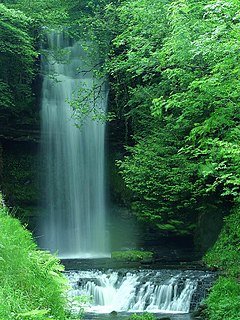 Glencar Waterfall, Glencar Lough | |
|---|---|
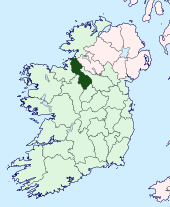
| |
| [Interactive map] | |
| Province: | Connaught |
| Area: | 613 square miles |
| Population: | 31,798 |
| County seat: | Leitrim |
The County of Leitrim is a shire in the Republic of Ireland, belonging to the Province of Connaught. It is named after the village of Leitrim. The population of the county is 31,798 according to the 2011 census.[1]
Geography
Leitrim is the 26th largest of the 32 counties by area and the smallest by population on the island.[2] It is the smallest of Connaught’s five counties in both size and population. Leitrim is bordered by the counties of Donegal to the north, Fermanagh to the north-east, Cavan to the east, Longford to the south, Roscommon to the south-west and Sligo to the west. Fermanagh is in Northern Ireland while all the other neighbouring counties are within the Republic.
The townlands of Edercloon[3] and Clooneen (Shanly)[4] form two distinct detached parts of the county locally situate in the county of Longford.
Baronies
There are five baronies in the county. They are Carrigallen, Drumahaire, Leitrim, Mohill and Rosclogher.[5]
Largest towns
- Carrick-on-Shannon, 3,980
- Manorhamilton, 1,336
- Ballinamore, 889
- Kinlough, 1,018
- Mohill, 928
Towns & villages in north Leitrim
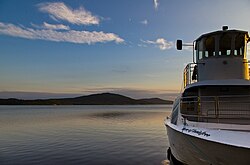


- Allentown, County Leitrim
- Askill
- Ballinaglera
- Buckode
- Cloonsheerevagh
- Drumkeeran
- Dromahair
- Dowra
- Friarstown
- Glenfarne
- Glenade
- Kiltyclogher
- Kinlough
- Killarga
- Largydonnell
- Lurganboy
- Manorhamilton
- Rossinver
- Tullaghan
Towns & villages in south Leitrim
- Aghamore
- Ballinamore
- Carrick-on-Shannon
- Carrigallen
- Cloone
- Drumcong
- Dromod
- Drumshanbo
- Drumsna
- Fenagh
- Eslinbridge
- Jamestown
- Johnstownbridge
- Keshcarrigan
- Leitrim
- Mohill
- Newtowngore
Civil parishes
Geography
Leitrim has a hilly and mountainous landscape in its north-west and is relatively flat in the south-east, each separated from the other by Lough Allen in the middle of the county. Leitrim has the shortest length of coastline of any Irish county that touches the sea. At Tullaghan, the coastline is only 1½ miles long.[6] The Shannon is linked to the Erne via the Shannon-Erne Waterway. Notable lakes include:
- Lough Melvin
- Lough Allen
- Lough Gill is to the north-west of Dromahair; Parke's Castle is located on the lake shore.
- Belhavel Lough is also located in Dromahair, within the parish of Killargue.
- Other lakes include Upper Lough MacNean, Glencar Lough, Glenade Lough, Garadice Lough, Rinn Lough and Lough Scannal.
History
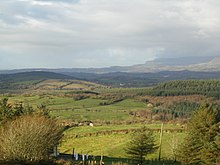
In ancient times Leitrim formed the western half of the Kingdom of Breifne. This region was long influenced by the O'Rourke family of Dromahair, whose heraldic lion occupies the official county shield to this day. Close ties initially existed with the O'Reilly clan in the eastern half of the kingdom, however a split occurred in the 13th century and the kingdom was divided into East Breifne, now County Cavan, and West Breifne, now County Leitrim. The Normans invaded in the 13th century and occupied the south of Breifne. Much of the county was confiscated from its owners in 1620 and given to Villiers and Hamilton. Their initial objective was to plant the county with English settlers. However, this proved unsuccessful. English Deputy Sir John Perrot had ordered the legal establishment of "Leitrim County" a half-century prior, in 1565. Perrott also demarked the current county borders around 1583. Five forests are traditionally said to have stood in Leitrim up till the 17th century.
Leitrim was first hit by the recession caused by the mechanisation of linen weaving in the 1830s and its 155,000 residents (as of the 1841 census) were ravaged by the Great Famine and the population dropped to 112,000 by 1851. The population subsequently continued to decrease due to emigration. After many years, the wounds of such rapid population decline have finally started to heal. Agriculture improved over the last century. Leitrim now has the fastest growing population in Connaught.
Working of the county's rich deposits of iron ore began in the 15th century and continued until the mid 18th century. Coal mining became prominent in the 19th century to the east of Lough Allen in Sliabh an Iariann and also to the west in Arigna, on the Roscommon border. The last coal mine closed in July 1990 and there is now a visitor centre.[7] Sandstone was also quarried in the Glenfarne region. William Butler Yeats spent the turn of the twentieth century fascinated with Lough Allen and much of Leitrim. In the north-west, seven miles from Manorhamilton can be found Glencar Waterfall, which was an inspiration to Yeats and is mentioned in his poem The Stolen Child.
Demographics
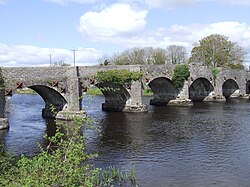
- Leitrim has the fastest growing population of any county in Connaught. As measured by census, the population rose by 12.2% between 2002 and 2006 to 29,000.[8]
- 2005 HEA statistics identified that Leitrim has the highest rate of participation in higher education in the Republic with 75% of 17-19 year olds being admitted to a higher course.[9]
- The county town is Carrick-on-Shannon (3,505 inhabitants).[10] It is a highly developed, prospering river port on the River Shannon and many tourists hire cruising boats here to explore the Shannon and the Shannon-Erne Waterway — a 39-mile canal linking the two river systems. It is amongst the fastest growing towns in Ireland having grown by 25% in the past few years.[11]
Transport
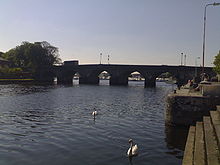
- Supplementing the local and regional road networks are the N15 (Sligo-Leitrim-Donegal), N16 (Sligo-Leitrim-Enniskillen) and N4 (Sligo-Leitrim-Dublin) national roads.
- Railway stations in Leitrim on the Dublin to Sligo line include Dromod and Carrick-on-Shannon.
- The Cavan and Leitrim Railway opened on 17 October 1887. It consisted of two branches, meeting at Ballinamore which connected Dromod and Arigna with Belturbet. Services carried goods, passengers and coal from around Lough Allen. Although protested, the line finally closed on 31 March 1959.
- Railway stations in Leitrim on the former Sligo, Sligo-Enniskillen Railway included Dromahair, Manorhamilton and Glenfarne.
- The Shannon and Shannon-Erne Waterway give access to much of Leitrim by boat.
People
- Katherine Lynch - comedienne.
- John McGahern - author.
- Pat Quinn - founder of Quinnsworth.
- Patrick McGoohan - actor.
- Paul Williams - journalist.
- Seán Mac Diarmada - Irish republican.
- Thomas Heazle Parke - explorer, naturalist.
- Patrick Rogan - US Army soldier and Medal of Honor recipient.
- James Gralton - (17 April 1886–1945) was an Irish communist leader, who became a United States citizen after emigrating in 1909, and the only Irishman ever deported from Ireland. Born in Effrinagh
References
- ↑ Census 2011 County Leitrim Overview
- ↑ Corry, Eoghan (2005). The GAA Book of Lists. Hodder Headline Ireland. pp. 186–191.
- ↑ Townland of Edercloon: 53°48’47"N, 7°53’29"W
- ↑ Townland of Clooneen (Shanly): 53°48’9"N, 7°54’3"W
- ↑ Placenames Database of Ireland. Baronies of County Leitrim. Retrieved 5 December 2011.
- ↑ An Article on the geography/history of Leitrim http://www.libraryireland.com/Atlas/Leitrim.php
- ↑ Sliabh an Iarainn Visitor Centre
- ↑ Population increase in Co. Leitrim
- ↑ HEA statistics 2005
- ↑ "Population and area of each Province, County, City, urban area, rural area and Electoral Division, 2002 and 2006" (pdf). Census 2006, Volume 1 - Population Classified by Area. CSO. 2007-04-26. pp. page 106. http://www.cso.ie/census/documents/census2006_Table_6.pdf. Retrieved 2008-05-29.
- ↑ "IDA Population information on Carrick-on-Shannon". http://www.idaireland.com/home/index.aspx?id=281.
Outside links
| Counties of the Republic of Ireland |
|---|
|
Carlow • Cavan • Clare • Cork • Donegal • Dublin • Galway • Kerry • Kildare • Kilkenny • Laois • Leitrim • Limerick • Longford • Louth • Mayo • Meath • Monaghan • Offaly • Roscommon • Sligo • Tipperary • Waterford • Westmeath • Wexford • Wicklow |